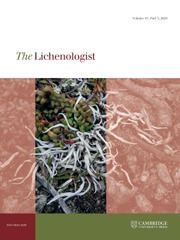Crossref Citations
This article has been cited by the following publications. This list is generated based on data provided by
Crossref.
Esslinger, Theodore L.
2005.
Recent Literature on Lichens—198*.
The Bryologist,
Vol. 108,
Issue. 3,
p.
459.
Divakar, Pradeep K.
Crespo, Ana
Blanco, Oscar
and
Lumbsch, H. Thorsten
2006.
Phylogenetic significance of morphological characters in the tropical Hypotrachyna clade of parmelioid lichens (Parmeliaceae, Ascomycota).
Molecular Phylogenetics and Evolution,
Vol. 40,
Issue. 2,
p.
448.
Hawksworth, David L.
2006.
Pandora's Mycological Box: Molecular sequences vs. morphology in understanding fungal relationships and biodiversity.
Revista Iberoamericana de Micología,
Vol. 23,
Issue. 3,
p.
127.
ARGÜELLO, ARTURO
DEL PRADO, RUTH
CUBAS, PALOMA
and
CRESPO, ANA
2007.
Parmelina quercina (Parmeliaceae, Lecanorales) includes four phylogenetically supported morphospecies.
Biological Journal of the Linnean Society,
Vol. 91,
Issue. 3,
p.
455.
Feuerer, Tassilo
and
Hawksworth, David L.
2007.
Biodiversity of lichens, including a world-wide analysis of checklist data based on Takhtajan’s floristic regions.
Biodiversity and Conservation,
Vol. 16,
Issue. 1,
p.
85.
Lumbsch, H. Thorsten
Mangold, Armin
Martín, María P.
and
Elix, John A.
2008.
Species recognition and phylogeny of Thelotrema species in Australia (Ostropales, Ascomycota).
Australian Systematic Botany,
Vol. 21,
Issue. 3,
p.
217.
Otálora, Mónica A.G.
Martínez, Isabel
Molina, Carmen M.
Aragón, Gregorio
and
Lutzoni, François
2008.
Phylogenetic relationships and taxonomy of the Leptogium lichenoides group (Collemataceae, Ascomycota) in Europe.
TAXON,
Vol. 57,
Issue. 3,
p.
907.
Crespo, Ana
and
Pérez-Ortega, Sergio
2009.
Cryptic species and species pairs in lichens: A discussion on the relationship between molecular phylogenies and morphological characters.
Anales del Jardín Botánico de Madrid,
Vol. 66,
Issue. S1,
p.
71.
KRZEWICKA, Beata
GARCÍA, Miguel A.
JOHANSEN, Steinar D.
SANCHO, Leopoldo G.
and
MARTÍN, María P.
2009.
Morphological and nuclear ribosomal DNA data support distinguishing two new species ofUmbilicaria(Umbilicariaceae, Ascomycota) from Europe.
The Lichenologist,
Vol. 41,
Issue. 6,
p.
631.
THELL, Arne
HÖGNABBA, Filip
ELIX, John A.
FEUERER, Tassilo
KÄRNEFELT, Ingvar
MYLLYS, Leena
RANDLANE, Tiina
SAAG, Andres
STENROOS, Soili
AHTI, Teuvo
and
SEAWARD, Mark R. D.
2009.
Phylogeny of the cetrarioid core (Parmeliaceae) based on five genetic markers.
The Lichenologist,
Vol. 41,
Issue. 5,
p.
489.
Elix, John A.
Corush, Joel
and
Lumbsch, H.Thorsten
2009.
Triterpene chemosyndromes and subtle morphological characters characterise lineages in thePhyscia aipoliagroup in Australia (Ascomycota).
Systematics and Biodiversity,
Vol. 7,
Issue. 4,
p.
479.
Divakar, Pradeep K.
Lumbsch, H. Thorsten
Ferencova, Zuzana
Del Prado, Ruth
and
Crespo, Ana
2010.
Remototrachyna, a newly recognized tropical lineage of lichens in the Hypotrachyna clade (Parmeliaceae, Ascomycota), originated in the Indian subcontinent.
American Journal of Botany,
Vol. 97,
Issue. 4,
p.
579.
Otálora, Mónica A.G.
Aragón, Gregorio
Molina, M. Carmen
Martínez, Isabel
and
Lutzoni, François
2010.
Disentangling theCollema-Leptogiumcomplex through a molecular phylogenetic study of the Collemataceae (Peltigerales, lichen-forming Ascomycota).
Mycologia,
Vol. 102,
Issue. 2,
p.
279.
CZARNOTA, Paweł
and
GUZOW-KRZEMIŃSKA, Beata
2010.
A phylogenetic study of theMicarea prasinagroup shows thatMicarea micrococcaincludes three distinct lineages.
The Lichenologist,
Vol. 42,
Issue. 1,
p.
7.
Crespo, Ana
and
Lumbsch, H. Thorsten
2010.
Cryptic species in lichen-forming fungi.
IMA Fungus,
Vol. 1,
Issue. 2,
p.
167.
Divakar, Pradeep K.
Figueras, Gemma
Hladun, Nestor L.
and
Crespo, Ana
2010.
Molecular phylogenetic studies reveal an undescribed species within the North American concept of Melanelixia glabra (Parmeliaceae).
Fungal Diversity,
Vol. 42,
Issue. 1,
p.
47.
Printzen, Christian
2010.
Progress in Botany, Vol. 71.
Vol. 71,
Issue. ,
p.
233.
Del-Prado, Ruth
Cubas, Paloma
Lumbsch, H. Thorsten
Divakar, Pradeep K.
Blanco, Oscar
de Paz, Guillermo Amo
Molina, M. Carmen
and
Crespo, Ana
2010.
Genetic distances within and among species in monophyletic lineages of Parmeliaceae (Ascomycota) as a tool for taxon delimitation.
Molecular Phylogenetics and Evolution,
Vol. 56,
Issue. 1,
p.
125.
Lumbsch, H. Thorsten
and
Leavitt, Steven D.
2011.
Goodbye morphology? A paradigm shift in the delimitation of species in lichenized fungi.
Fungal Diversity,
Vol. 50,
Issue. 1,
p.
59.
DEL-PRADO, Ruth
DIVAKAR, Pradeep K.
and
CRESPO, Ana
2011.
Using genetic distances in addition to ITS molecular phylogeny to identify potential species in theParmotrema reticulatumcomplex: a case study.
The Lichenologist,
Vol. 43,
Issue. 6,
p.
569.


